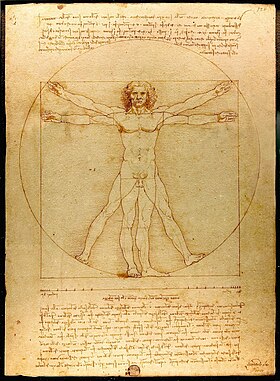
Back إنسانية مسيحية Arabic انسانيه مسيحيه ARZ Humanismu cristianu AST Християнски хуманизъм Bulgarian Humanisme cristià Catalan Kristana humanismo Esperanto Humanismo cristiano Spanish انسانگرایی مسیحی Persian Humanisme chrétien French הומניזם נוצרי HE

"In his explicit turn back to an ancient model in search of knowledge and wisdom, Leonardo follows early humanist practice. What he finds in Vitruvius is a mathematical formula for the proportions of all parts of the human body, which results in its idealized representation as the true microcosmic measure of all things. [...]The perfection of this ideal human form corresponds visually to the early humanist belief in the unique central placement of human beings within the divine universal order and their consequent human grandeur and dignity, expressed in the philosopher Pico della Mirandola's Oration on the Dignity of Man (1486), known as the manifesto of the Renaissance."
— Anne Hudson Jones[1]
Christian humanism regards classical humanist principles such as universal human dignity, individual freedom, and the importance of happiness as essential and principal or even exclusive components of the teachings of Jesus.
Proponents of the term trace the concept to the Renaissance, linking their beliefs to the scholarly movement and worldview often called just humanism.[2]
- ^ Hudson Jones, Anne. "Neh Institute". uva.theopenscholar.com.
- ^ Rummel, Erika; MacPhail, Eric (2024). "Desiderius Erasmus". The Stanford Encyclopedia of Philosophy. Metaphysics Research Lab, Stanford University.